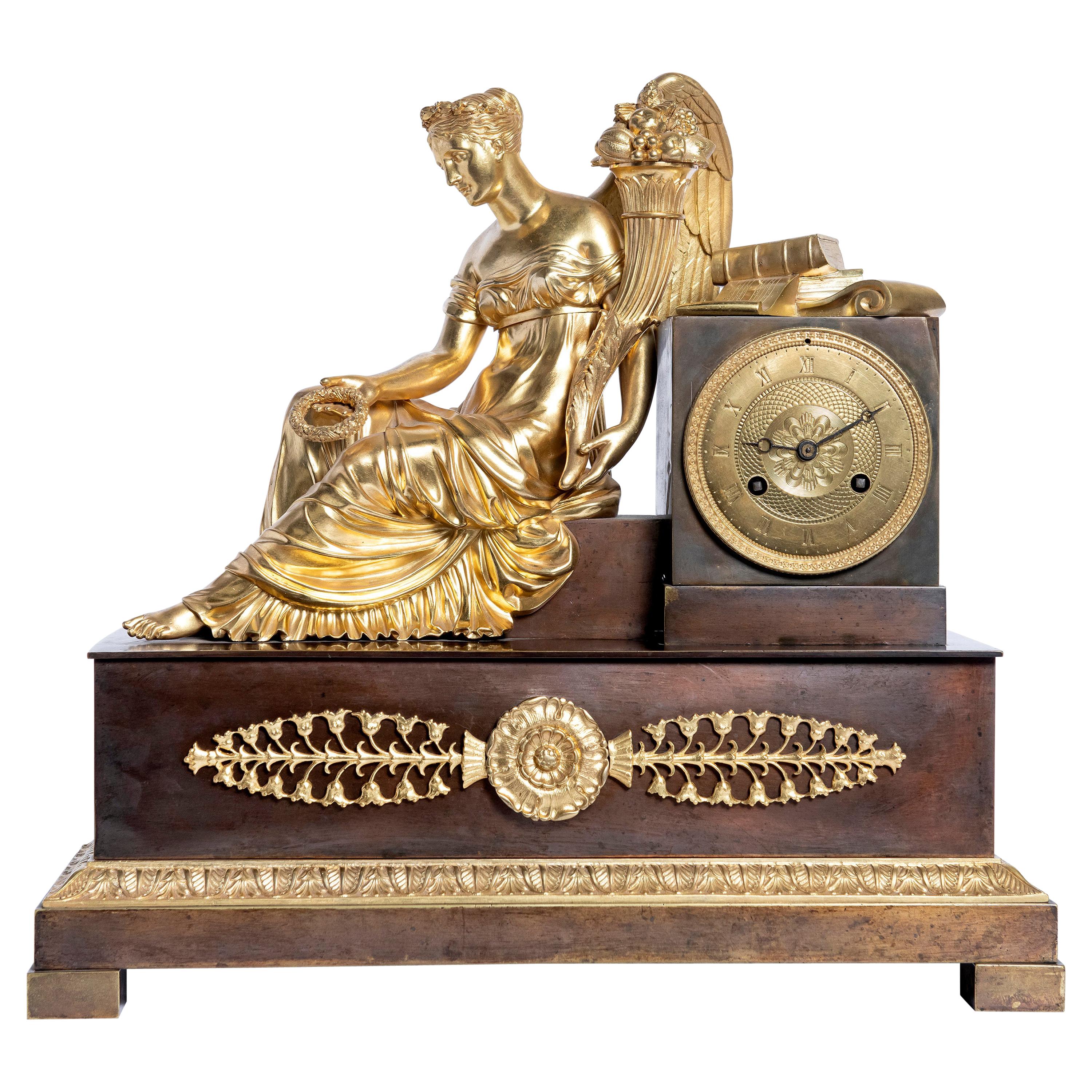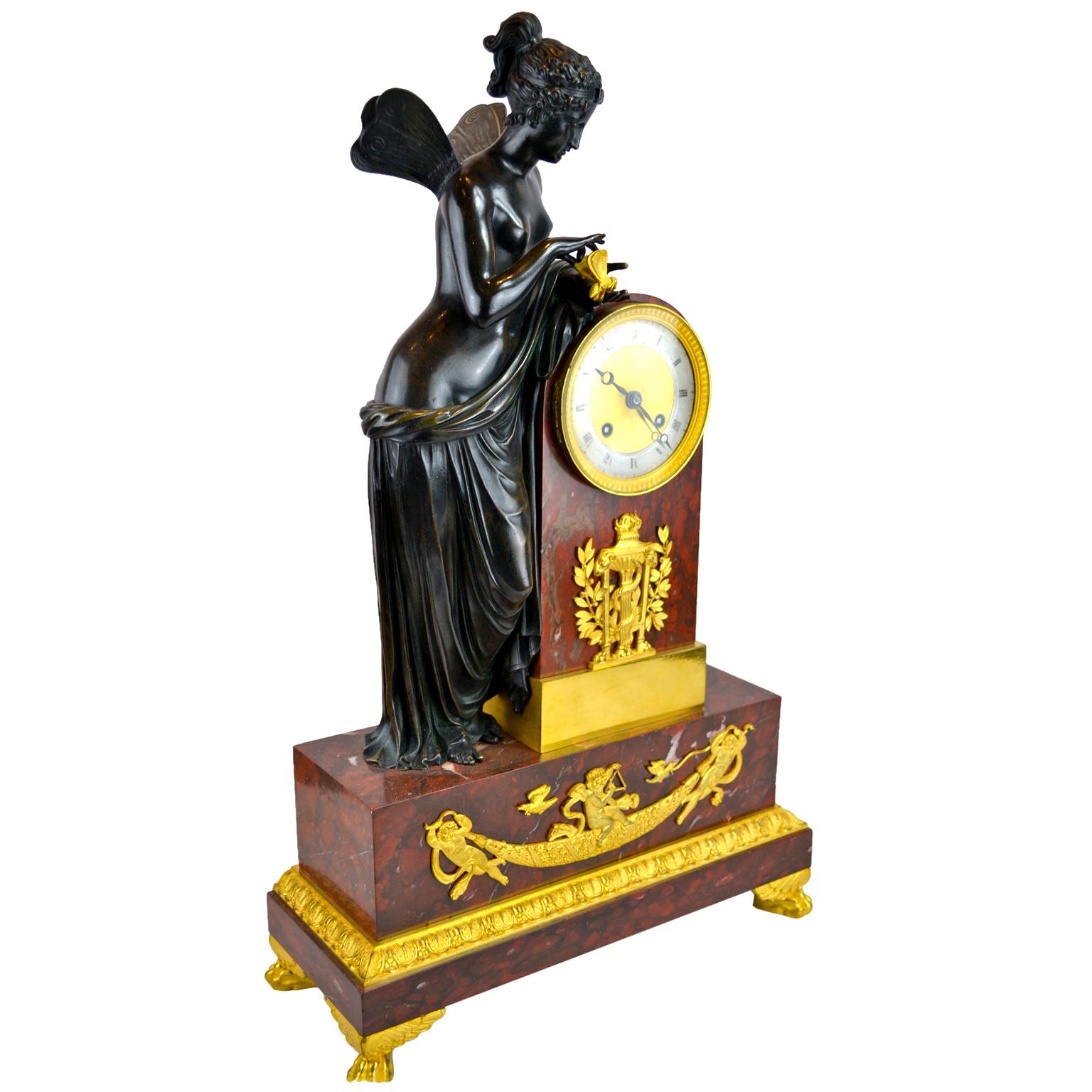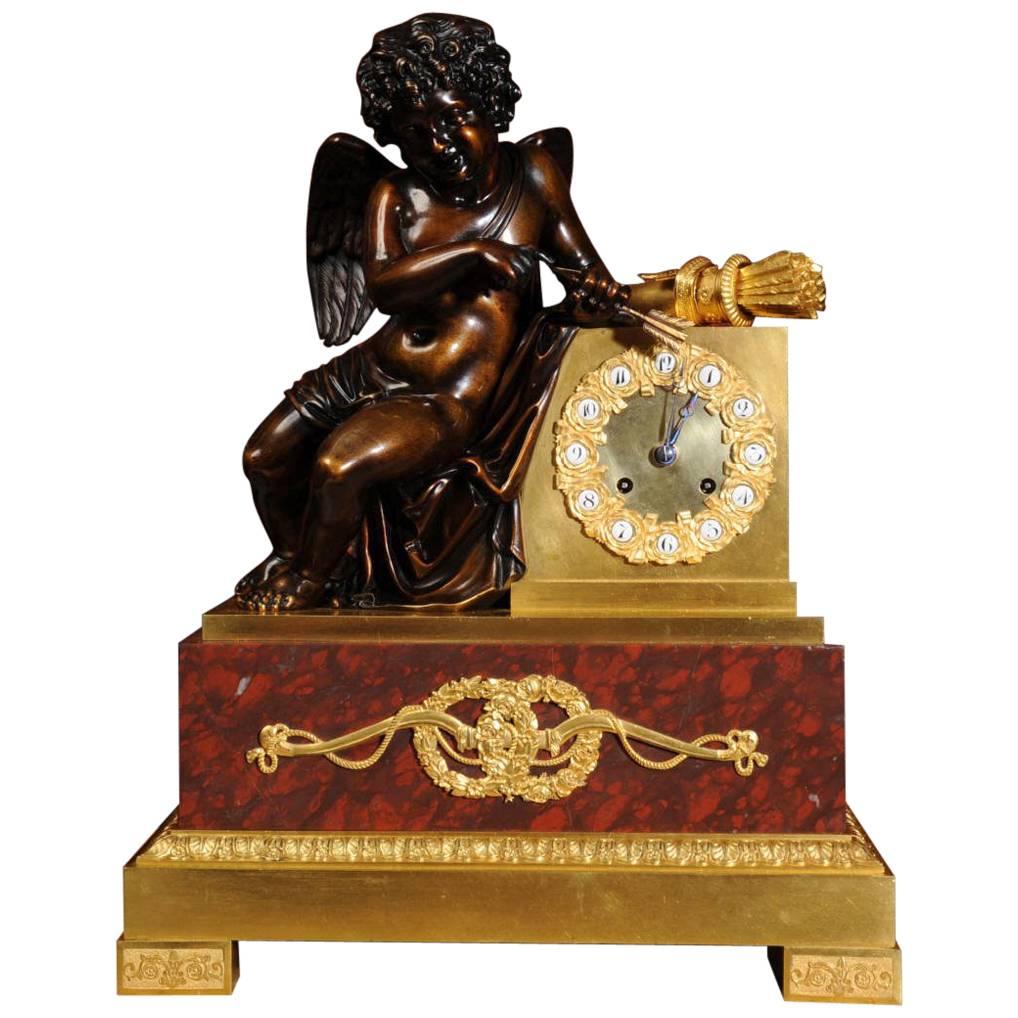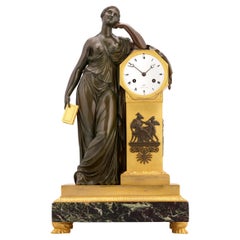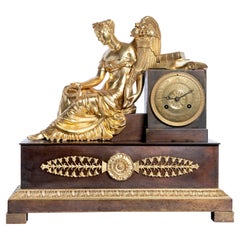Items Similar to Venus Clipping the Wings of Cupid Mantel Clock by Thomire & Cie
Want more images or videos?
Request additional images or videos from the seller
1 of 8
Venus Clipping the Wings of Cupid Mantel Clock by Thomire & Cie
$24,500
£18,850.16
€21,541.06
CA$35,065.34
A$38,238.12
CHF 20,087.49
MX$458,306.88
NOK 254,729.07
SEK 237,049.39
DKK 160,887.99
About the Item
This splendid Empire gilt bronze French mantel clock, signed on the dial by bronzier Pierre-Philippe Thomire and watchmaker Louis Moinet, features an exquisitely detailed scene of Venus clipping the wings of Cupid on a base of red cherry marble. Venus, embodying the essence of love and beauty, assumes a posture of regal elegance as she sits upon a bronze throne, delicately wielding punishing shears. Beside her, Cupid, her son, pleads for his freedom with an air of cherubic defiance. The goddess confronts conflicting emotions of maternal concern and divine authority as she administers Cupid's punishment.
Cupid is a mischievous god, and his antics often lead to his mother having to invoke maternal justice. In this gilded depiction of the mother and son, Venus clips Cupid’s wings to keep him from flying away just as one may treat a wandering pet bird. In this stunning clock, love and punishment intertwine in a delicate dance of fate.
Pierre-Philippe Thomire, a prominent French artisan of the Neoclassical period, distinguished himself as a master bronzier during the Empire. Born in Paris, Thomire apprenticed under the esteemed sculptor and chaser Pierre Gouthière, refining his skills in the intricate art of bronze casting and chasing. Establishing his own workshop in 1776, Thomire rapidly gained recognition for his exceptional craftsmanship, becoming the preeminent bronzier of his era. His creations, characterized by meticulous detailing and refined design, exemplify the Neoclassical aesthetic. This exquisite mantel clock, crafted in the 19th century, remains an enduring testament to Thomire's artistic legacy.
Louis Moinet, a highly esteemed watchmaker, inventor, scholar and manufacturer of precision instruments, became president of the Société de Chronométrie in Paris. Born in Bourges, he spent five years in Rome where he studied architecture, sculpture and painting. Moinet was well acquainted with the arts and, for this reason, he fully understood the aesthetic importance of each of his clocks. Moinet also achieved fame with his book, Nouveau traité général et civil Astronomique et pratique de l'horlogerie, published in 1843.
Moinet worked closely with the bronzier Thomire. The two were responsible for making many important clocks, including one for Napoleon Bonaparte in 1806, known as the Napoleon clock, now at the National Museum Speelklok in Utrecht. Moinet and Thomire also collaborated on clocks for the King of Naples, George IV of England and Tsar Alexander of Russia. While in Paris, Thomas Jefferson acquired a clock from Moinet and Thomire, which accompanied the President for two terms in the White House. When James Monroe became president, he also commissioned a clock from the pair in 1817.
Circa 19th Century
16 1/4" high by 14 1/8" wide by 7 7/8" wide
- Creator:Louis Moinet,Thomire & Cie. (Maker)
- Dimensions:Height: 16.25 in (41.28 cm)Width: 14.13 in (35.9 cm)Depth: 7.81 in (19.84 cm)
- Style:Empire (In the Style Of)
- Materials and Techniques:
- Place of Origin:
- Period:
- Date of Manufacture:Circa 19th Century
- Condition:
- Seller Location:New Orleans, LA
- Reference Number:Seller: 31-86491stDibs: LU891142300962
About the Seller
5.0
Recognized Seller
These prestigious sellers are industry leaders and represent the highest echelon for item quality and design.
Established in 1912
1stDibs seller since 2010
114 sales on 1stDibs
Typical response time: 4 hours
- ShippingRetrieving quote...Shipping from: New Orleans, LA
- Return Policy
More From This Seller
View AllMeditation French Empire Mantel Clock by Claude Galle
By Claude Galle
Located in New Orleans, LA
Empire Mantel Clock
Claude Galle
Circa 1810
This Empire period mantel clock by Galle exemplifies the sophisticated allegorical artistry of early 19th-century French horology. Repres...
Category
Antique 19th Century French Empire Table Clocks and Desk Clocks
Materials
Marble, Bronze, Enamel
The Astronomy Lesson French Empire Mantel Clock
Located in New Orleans, LA
This magnificent French Empire ormolu mantel clock features the iconic Neoclassical genre scene often referred to as "The Astronomy Lesson." A popular motif during this period, Emper...
Category
Antique 19th Century French Empire Mantel Clocks
Materials
Marble, Enamel, Ormolu
French Empire Troubadour Mantel Clock
By Le Roy
Located in New Orleans, LA
This resplendent French Empire gilt bronze mantel clock features an extraordinarily detailed scene of a singing troubadour with his lyre along a rocky river bank. Accompanied by a wi...
Category
Antique 19th Century French Empire Mantel Clocks
Materials
Marble, Bronze
Odysseus and Theseus French Empire Mantle Clock by André Antoine Ravrio
Located in New Orleans, LA
Odysseus and Theseus French Empire Mantel Clock
André Antoine Ravrio
Circa 1800
This monumental Empire mantel clock by André Antoine Ravrio, whose case is crafted entirely of gilded...
Category
Antique Early 19th Century French Empire Mantel Clocks
Materials
Bronze
Louis XVI Marble Mantle Clock by Jean-Nicolas Schmit
Located in New Orleans, LA
A horologic masterpiece of precision and beauty, this neoclassical marble and ormolu mantle clock is an extraordinary example of late 18th-century French clockmaking by the famed Jea...
Category
Antique 18th Century French Neoclassical Mantel Clocks
Materials
Marble, Ormolu
French Fluorspar and Ormolu Clock Garniture
Located in New Orleans, LA
This beautiful French clock garniture, styled in the Louis XV taste, is a charming work of artistry and craftsmanship. Crafted of richly veined and brightly-hued fluorspar mounted wi...
Category
Antique 19th Century French Rococo Mantel Clocks
Materials
Stone, Bronze
You May Also Like
Gilt and Patinated Bronze Mantel Clock, Machine Signed L. Moinet, France
By Louis Moinet
Located in Buenos Aires, Buenos Aires
Gilt and patinated bronze mantel clock, machine signed L. Moinet A Paris. France, early 19th century.
Category
Antique Early 19th Century French Empire Mantel Clocks
Materials
Bronze
French Empire Clock Depicting Psyche Playing with a Butterfly After Canova
Located in Vancouver, British Columbia
A French Empire Clock depicting Psyche playing with a butterfly after a marble statue by Canova displayed in the Louvre. A patinated bronze Psych...
Category
Antique Early 19th Century French Empire Mantel Clocks
Materials
Bronze
French Empire Gilt Bronze Mantel Clock with Venus and Cupid
Located in London, GB
French Empire gilt bronze mantel clock with Venus and Cupid
French, early 19th Century
Measures: Height 53cm, width 37.5cm, depth 13.5cm
This fine Empire period mantel clock is crafted from gilt bronze. The clock includes a sculptural surmount of Venus accompanied by Cupid. Venus sits atop the square clock...
Category
Antique Early 19th Century French Empire Mantel Clocks
Materials
Bronze, Ormolu
$7,099 Sale Price
30% Off
Early 19th Century Empire Mantel Clock by Ledure with Apollo or Eros
By Pierre-Victor Ledure, Claude Hemon
Located in Worpswede / Bremen, DE
The clock is signed on the enamel dial by the famous Parisian bronzier ”Ledure Bronzier à Paris” and the clockmaker ”Hedon Hr" (horloger). Patinated and fully sculpted bronze figure ...
Category
Antique Early 19th Century French Empire Mantel Clocks
Materials
Bronze
Early and Fine Bronze, Ormolu and Specimen Marble Clock with Cupid
Located in Belper, Derbyshire
A large, fine and exquisite, early antique French clock depicting cupid holding a sharpened golden arrow. It is of stunning quality and fully serviced and tested by our clockmakers. ...
Category
Antique Early 19th Century French Louis Philippe Mantel Clocks
Materials
Marble, Ormolu, Bronze
Period French Empire Mantle Clock Depicting a Winged Cupid Playing a Lute
By André-Antoine Ravrio
Located in Vancouver, British Columbia
A fine quality chased and gilded French Empire mantle clock depicting a standing winged cupid to the right of the clock plinth playing a lute. He looks to his right reading his sheet music and other elements including a torch, flambeau, wreath etc. On the left side of the clock plinth is a three legged...
Category
Antique Early 19th Century French Empire Mantel Clocks
Materials
Bronze
$3,040 Sale Price
20% Off
More Ways To Browse
Bronze Cupid
19th Century Bronze Goddess Sculpture
Venus Bronze
Venus And Cupid
Venus Marble
Marble Cupid
Thomas Jefferson
Pierre Gouthiere
Russian Tsar
Antique Shears and Scissors
Bird Clock
French Mantel Clock Red Marble
Cupid Mantel Clock
French Clocks Cupid
Bronze Throne
Gilt Bronze Clock Cupid
Thomire Clock
18th Century Clock Marble
